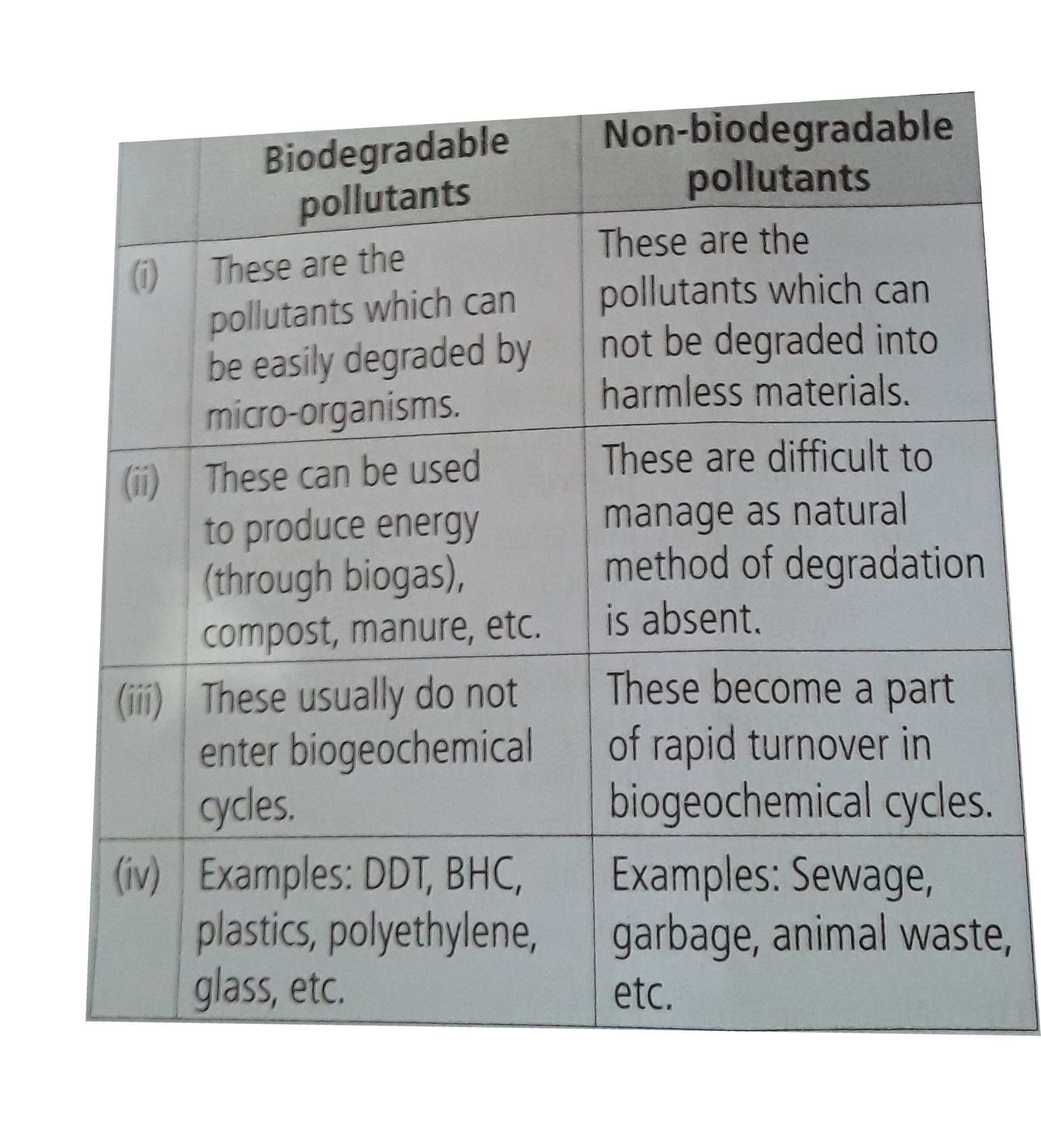What are biodegradable and non-biodegradable pollutants ?
Step-by-Step Solution:
1. Define Biodegradable Pollutants:
- Biodegradable pollutants are substances that can be broken down by natural processes, specifically by the action of microorganisms such as bacteria and fungi.
- Key Point: They can be decomposed by microbes.
2. Define Non-Biodegradable Pollutants:
- Non-biodegradable pollutants are substances that cannot be broken down by natural processes. They remain in the environment for a long time without decomposing.
- Key Point: They cannot be decomposed by natural processes.
3. Environmental Impact:
- Biodegradable pollutants are generally considered non-polluting and less harmful to the environment because they can be decomposed and recycled back into nature.
- Non-biodegradable pollutants, on the other hand, are harmful and contribute to environmental pollution since they accumulate in landfills and ecosystems.
4. Examples of Biodegradable Pollutants:
- Common examples include:
- Paper
- Vegetable waste
- Fruit waste
- Other organic materials
5. Examples of Non-Biodegradable Pollutants:
- Common examples include:
- Plastic bags
- Plastic bottles
- Styrofoam
- Other synthetic materials
Summary:
- Biodegradable Pollutants: Can be decomposed by microbes (e.g., paper, vegetable waste).
- Non-Biodegradable Pollutants: Cannot be decomposed (e.g., plastic bags, plastic bottles).
---
- Biodegradable pollutants are substances that can be broken down by natural processes, specifically by the action of microorganisms such as bacteria and fungi.
- Key Point: They can be decomposed by microbes.
- Non-biodegradable pollutants are substances that cannot be broken down by natural processes. They remain in the environment for a long time without decomposing.
- Key Point: They cannot be decomposed by natural processes.
- Biodegradable pollutants are generally considered non-polluting and less harmful to the environment because they can be decomposed and recycled back into nature.
- Non-biodegradable pollutants, on the other hand, are harmful and contribute to environmental pollution since they accumulate in landfills and ecosystems.
- Common examples include:
- Paper
- Vegetable waste
- Fruit waste
- Other organic materials
- Common examples include:
- Plastic bags
- Plastic bottles
- Styrofoam
- Other synthetic materials
- Biodegradable Pollutants: Can be decomposed by microbes (e.g., paper, vegetable waste).
- Non-Biodegradable Pollutants: Cannot be decomposed (e.g., plastic bags, plastic bottles).
Topper's Solved these Questions
- BOOK - NCERT EXEMPLAR ENGLISHCHAPTER - ENVIRONMENTAL CHEMISTRYEXERCISE - Match the column4videos
ENVIRONMENTAL CHEMISTRY
- BOOK - NCERT EXEMPLAR ENGLISHCHAPTER - ENVIRONMENTAL CHEMISTRYEXERCISE - Assertion And Reason7videos
ENVIRONMENTAL CHEMISTRY
- BOOK - NCERT EXEMPLAR ENGLISHCHAPTER - ENVIRONMENTAL CHEMISTRYEXERCISE - Long Answer Type5videos
ENVIRONMENTAL CHEMISTRY
- BOOK - NCERT EXEMPLAR ENGLISHCHAPTER - CLASSIFICATION OF ELEMENTS AND PERIODICITY IN PROPERTIES.EXERCISE - Long answer types question7videos
CLASSIFICATION OF ELEMENTS AND PERIODICITY IN PROPERTIES.
- BOOK - NCERT EXEMPLAR ENGLISHCHAPTER - HYDROCARBONSEXERCISE - Long Answer Type Questions4videos
HYDROCARBONS
Similar Questions
Knowledge Check
- Question 1 - Select One
The following table summarises the differences between biodegradable and non-biodegradable pollutants. Pick out the wrong diggerences and select the correct answer.
 A(i) and (iv)B(ii) and (iv)C(iii) and (iv)D(ii), (iii) and (iv)
A(i) and (iv)B(ii) and (iv)C(iii) and (iv)D(ii), (iii) and (iv)
Given one significant difference between each of the following :
(i) Pollution and Pollutants .
(ii) Biodegradable and Nonbiodegradable pollutants .View SolutionSort out non-biodegradable and biodegradable pollutants among the following : Mercury salts, sewage, plant leaves, BHC, cadmium salts.
View SolutionIs DDT a biodegradable pollutant ?
View SolutionDifferentiate between biodegradable and non-biodegradable substances.
Give examples.View SolutionPolythene is a non- biodegradable pollutant .
View SolutionWhy are some substances biodegradable and some non-biodegradable?
View SolutionDDT is
(a) green house gas
(b) degradable pollutant
(c) non-degradable pollutant
(d) None of the aboveView Solution
